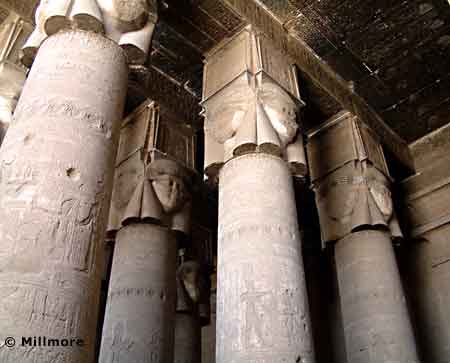
Cult temple dedicated to the goddess Hathor dating from 380 BC
The Temple of Dendara is one of the best-preserved temples in Egypt. It was known as the “Castle of the Sistrum” or “Pr Hathor”— House of Hathor.
 Hathor was the goddess of love, joy, and beauty.
Hathor was the goddess of love, joy, and beauty.
With the exception of its supporting pillars, which had capitals sculpted in the image of Hathor and were defaced by the Christians, the walls, rooms, and roof are complete and extraordinarily well preserved. The stone steps of the spiral staircase are time worn but may still be used to ascend to the roof, where there is a small chapel decorated with Hathor-headed columns.
In ancient times, Dendara was associated with healing. Patients who traveled there for cures were housed in special buildings where they could rest, sleep, and commune with the gods in their dreams. There is something else special about this temple, as well: It bears the name of Cleopatra and her son, whose father was Julius Caesar. It is  possible that these celebrated rulers climbed the same stairs and contemplated the same landscape stretching out for miles below.
possible that these celebrated rulers climbed the same stairs and contemplated the same landscape stretching out for miles below.
Today, the place sings with the music of birds. Hundreds of them roost in small cracks and hollows in the walls, seemingly contemplating their own carved likenesses in the hieroglyphic reliefs.
There have been temples on this site ever since the Old Kingdom, but the present temple was begun in the reign of Ptolemy VIII. The building we see today was constructed and added to from about 116 BC to 34 AD.

The mystery of Egyptian cult temples explained, illustrated with videos, photos, drawings and 30 highly detailed computer generated reconstructions.








